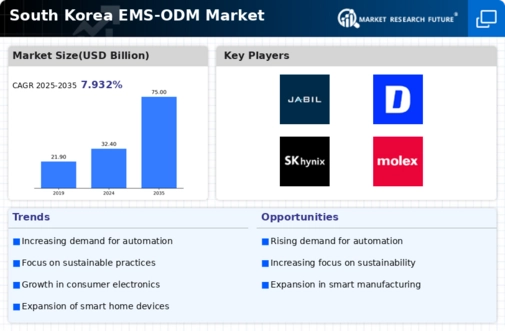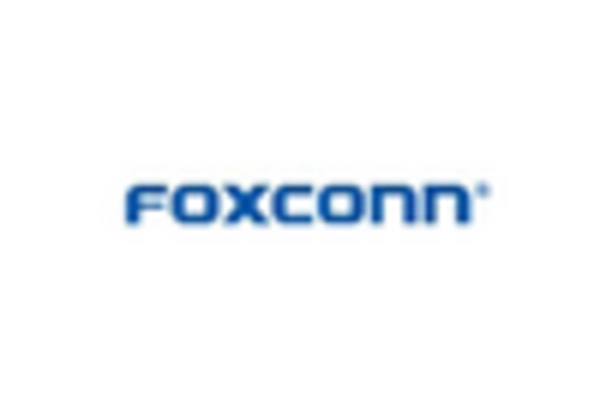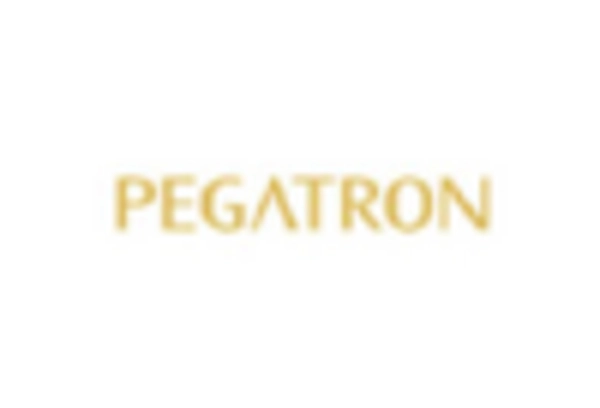Focus on Quality Assurance
Quality assurance remains a critical driver in the ems odm market, particularly in South Korea, where consumers exhibit a strong preference for reliable and durable products. As competition intensifies, manufacturers are increasingly prioritizing quality control measures to differentiate their offerings. The implementation of stringent quality standards is essential for maintaining consumer trust and brand loyalty. In 2025, it is estimated that companies investing in quality assurance processes will see a 20% increase in customer satisfaction ratings. This focus on quality not only enhances the reputation of ems odm providers but also contributes to the overall growth of the market. As a result, companies are likely to allocate more resources towards quality management systems to ensure compliance with international standards.
Emerging Trends in Sustainability
Sustainability is becoming an increasingly vital consideration within the ems odm market, as consumers and businesses alike prioritize environmentally friendly practices. In South Korea, there is a growing emphasis on reducing carbon footprints and utilizing sustainable materials in manufacturing processes. This trend is reflected in the rising demand for eco-friendly products, which is projected to grow by 15% annually. Companies that adopt sustainable practices are likely to gain a competitive edge in the ems odm market, appealing to environmentally conscious consumers. Furthermore, regulatory pressures are pushing manufacturers to comply with stricter environmental standards, prompting a shift towards greener production methods. This evolving landscape suggests that sustainability will play a crucial role in shaping the future of the ems odm market.
Government Support and Incentives
The South Korean government plays a pivotal role in fostering the ems odm market through various support initiatives and incentives. Policies aimed at promoting technological innovation and manufacturing efficiency are increasingly prevalent. For instance, the government has allocated substantial funding to support research and development in electronics manufacturing, which is expected to enhance the capabilities of local ems odm providers. Additionally, tax incentives for companies investing in advanced manufacturing technologies are likely to stimulate growth within the sector. This supportive environment not only encourages domestic companies to expand but also attracts foreign investment, further bolstering the ems odm market. As a result, the market is positioned for sustained growth, driven by both governmental and private sector initiatives.
Shift Towards Smart Manufacturing
The EMS ODM market is witnessing a significant shift towards smart manufacturing practices, characterized by the integration of automation and data analytics. This transformation is largely driven by the need for increased efficiency and reduced production costs. In South Korea, manufacturers are increasingly adopting Industry 4.0 technologies, which enable real-time monitoring and optimization of production processes. This trend is expected to enhance the competitiveness of local ems odm providers, allowing them to respond swiftly to market demands. By 2026, it is anticipated that smart manufacturing will account for over 50% of the production processes in the ems odm market. This evolution not only improves operational efficiency but also aligns with the growing consumer demand for high-quality, customized products.
Rising Demand for Consumer Electronics
The EMS ODM market in South Korea experiences a notable surge in demand for consumer electronics, driven by the increasing adoption of smart devices. As consumers seek innovative and high-quality products, manufacturers are compelled to enhance their production capabilities. In 2025, the market for consumer electronics is projected to reach approximately $30 billion, indicating a robust growth trajectory. This demand influences the ems odm market, as companies strive to meet consumer expectations for advanced technology and design. The competitive landscape necessitates that manufacturers not only focus on efficiency but also on the integration of cutting-edge technology in their offerings. Consequently, The EMS ODM market is likely to witness a shift towards more sophisticated manufacturing processes to cater to this evolving consumer preference.
















Leave a Comment